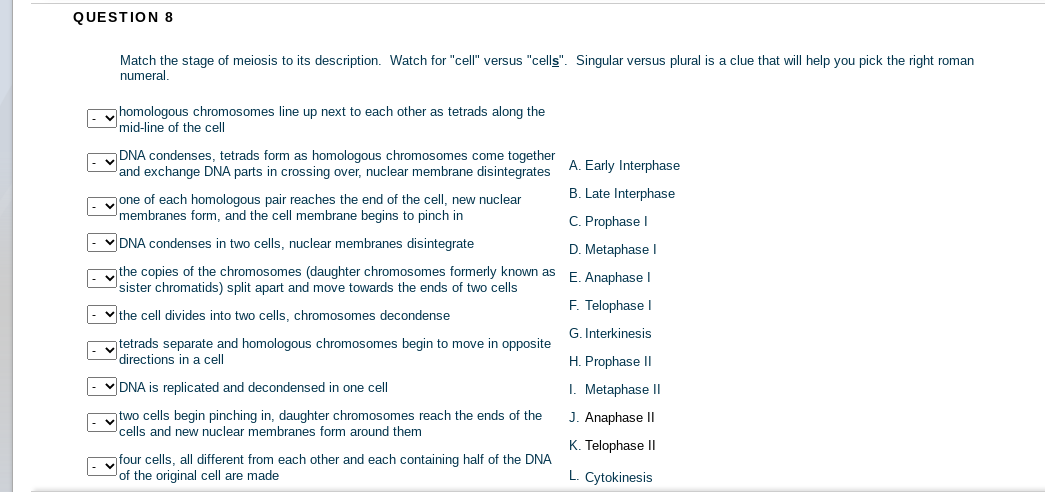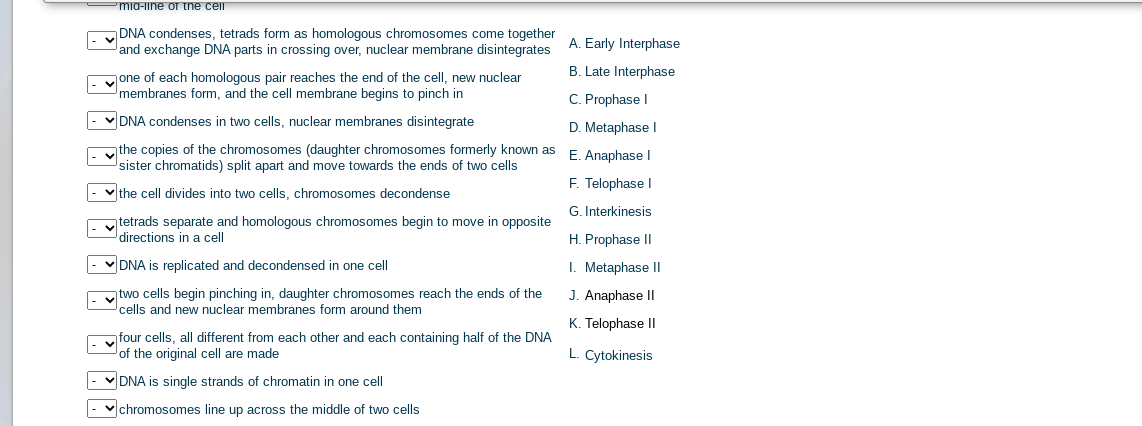Biology Today and Tomorrow without Physiology (MindTap Course List)
5th Edition
ISBN:9781305117396
Author:Cecie Starr, Christine Evers, Lisa Starr
Publisher:Cecie Starr, Christine Evers, Lisa Starr
Chapter8: How Cells Reproduce
Section: Chapter Questions
Problem 2FIO
Related questions
Topic Video
Question

Transcribed Image Text:QUESTION 8
Match the stage of meiosis to its description. Watch for "cell" versus "cells". Singular versus plural is a clue that will help you pick the right roman
numeral.
homologous chromosomes line up next to each other as tetrads along the
mid-line of the cell
DNA condenses, tetrads form as homologous chromosomes come together
and exchange DNA parts in crossing over, nuclear membrane disintegrates
A. Early Interphase
B. Late Interphase
yone of each homologous pair reaches the end of the cell, new nuclear
membranes form, and the cell membrane begins to pinch in
C. Prophase I
V DNA condenses in two cells, nuclear membranes disintegrate
D. Metaphase I
y the copies of the chromosomes (daughter chromosomes formerly known as
sister chromatids) split apart and move towards the ends of two cells
E. Anaphase I
F. Telophase I
|- v the cell divides into two cells, chromosomes decondense
G. Interkinesis
ytetrads separate and homologous chromosomes begin to move in opposite
directions in a cell
H. Prophase II
v DNA is replicated and decondensed in one cell
I. Metaphase II
ytwo cells begin pinching in, daughter chromosomes reach the ends of the
cells and new nuclear membranes form around them
J. Anaphase II
K. Telophase II
four cells, all different from each other and each containing half of the DNA
of the original cell are made
L. Cytokinesis

Transcribed Image Text:Pmia-Iine or the cel
DNA condenses, tetrads form as homologous chromosomes come together
and exchange DNA parts in crossing over, nuclear membrane disintegrates
A. Early Interphase
B. Late Interphase
one of each homologous pair reaches the end of the cell, new nuclear
membranes form, and the cell membrane begins to pinch in
C. Prophase I
|- VDNA condenses in two cells, nuclear membranes disintegrate
D. Metaphase I
the copies of the chromosomes (daughter chromosomes formerly known as
sister chromatids) split apart and move towards the ends of two ells
E. Anaphase I
F. Telophase I
- v the cell divides into two cells, chromosomes decondense
G. Interkinesis
tetrads separate and homologous chromosomes begin to move in opposite
directions in a cell
H. Prophase II
|- VDNA is replicated and decondensed in one cell
I. Metaphase II
two cells begin pinching in, daughter chromosomes reach the ends of the
cells and new nuclear membranes form around them
J. Anaphase II
K. Telophase II
four cells, all different from each other and each containing half of the DNA
of the original cell are made
L. Cytokinesis
V DNA is single strands of chromatin in one cell
vchromosomes line up across the middle of two cells
Expert Solution
This question has been solved!
Explore an expertly crafted, step-by-step solution for a thorough understanding of key concepts.
This is a popular solution!
Trending now
This is a popular solution!
Step by step
Solved in 2 steps

Knowledge Booster
Learn more about
Need a deep-dive on the concept behind this application? Look no further. Learn more about this topic, biology and related others by exploring similar questions and additional content below.Recommended textbooks for you

Biology Today and Tomorrow without Physiology (Mi…
Biology
ISBN:
9781305117396
Author:
Cecie Starr, Christine Evers, Lisa Starr
Publisher:
Cengage Learning

Human Heredity: Principles and Issues (MindTap Co…
Biology
ISBN:
9781305251052
Author:
Michael Cummings
Publisher:
Cengage Learning

Biology Today and Tomorrow without Physiology (Mi…
Biology
ISBN:
9781305117396
Author:
Cecie Starr, Christine Evers, Lisa Starr
Publisher:
Cengage Learning

Human Heredity: Principles and Issues (MindTap Co…
Biology
ISBN:
9781305251052
Author:
Michael Cummings
Publisher:
Cengage Learning